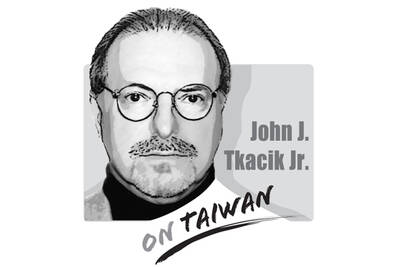The air force’s fighter jets are on the front line of the nation’s Taiwan Strait defense. Whether carrying out routine expulsions of marauding aircraft of the Chinese People’s Liberation Army (PLA) Air Force or combat patrol missions, the Taiwanese air defense forces are always performing a frontline role.
During an armed conflict, as long as airbase runways have not been destroyed by the enemy, aircraft are able to land for refueling and rearmament before retaking to the air to rejoin the battle.
However, if the PLA were to flip the table and put Taiwan on the back foot by bombing the runways of its airbases, aircraft would temporarily be unable to take off, and airborne fighters unable to land.
To ensure that the nation’s airbases could cope with the first wave of PLA missile attacks and postpone an air war, Taiwan must energetically lobby Washington to sell it refueling aircraft.
As the nation’s F-16 jets are fitted with refueling probes, refueling aircraft would not only enable Taiwan to sustain its capability during an aerial battle, but if large parts of its fighter jet fleet are grounded due to destroyed runways, tanker aircraft could refuel the F-16s already in the air.
Tanker aircraft would preserve the nation’s fighting power and allow it to launch a counterattack.
Moreover, since PLA aircraft frequently loiter in or fly close to Taiwan’s southwestern airspace, purchasing refueling aircraft would be beneficial to the nation.
Alternatively, the military could convert some of its Lockheed Martin Hercules C-130 transport aircraft into the KC-130 extended-range tanker variant.
Their refueling capacity could be increased through the addition of 10,000-liter external fuel tanks, and the aircraft’s cargo compartment could also be configured to accommodate an additional 13,600-liter removable internal fuel tank.
Converting four to six of the military’s Hercules C-130 transporters would allow it to rapidly build up an air-to-air refueling squadron.
The nation’s fighter aircraft possess a potent air-to-air, ground and maritime attack capability. However, due to the limited number of aircraft at Taiwan’s disposal, the PLA’s increasingly frequent incursions into Taiwan’s airspace have significantly increased the cost of interception missions, causing extreme fatigue among air and ground crews.
Air-to-air refueling would not only extend the flying time of frontline fighter aircraft during peacetime and in combat, it would also dramatically reduce the replacement rate of aircraft.
As tensions in the South China Sea continue to rise, PLA aircraft and ships will likely continue to harass the neighboring countries, including Taiwan.
With air-to-air refuelers at Taiwan’s disposal, its fighter jets would be able to extend their attack area, enabling the reinforcement of defensive detachments on Itu Aba Island (Taiping Island, 太平島) and the Spratly Islands (Nansha Islands, 南沙群島), and allow Taiwan’s military to reinforce control over the South China Sea.
Ray Song is a graduate of National Chung Cheng University’s Institute of Strategic and International Affairs.
Translated by Edward Jones

Elbridge Colby, America’s Under Secretary of Defense for Policy, is the most influential voice on defense strategy in the Second Trump Administration. For insight into his thinking, one could do no better than read his thoughts on the defense of Taiwan which he gathered in a book he wrote in 2021. The Strategy of Denial, is his contemplation of China’s rising hegemony in Asia and on how to deter China from invading Taiwan. Allowing China to absorb Taiwan, he wrote, would open the entire Indo-Pacific region to Chinese preeminence and result in a power transition that would place America’s prosperity
When Democratic Progressive Party (DPP) caucus whip Ker Chien-ming (柯建銘) first suggested a mass recall of Chinese Nationalist Party (KMT) legislators, the Taipei Times called the idea “not only absurd, but also deeply undemocratic” (“Lai’s speech and legislative chaos,” Jan. 6, page 8). In a subsequent editorial (“Recall chaos plays into KMT hands,” Jan. 9, page 8), the paper wrote that his suggestion was not a solution, and that if it failed, it would exacerbate the enmity between the parties and lead to a cascade of revenge recalls. The danger came from having the DPP orchestrate a mass recall. As it transpired,
All 24 Chinese Nationalist Party (KMT) lawmakers and suspended Hsinchu Mayor Ann Kao (高虹安), formerly of the Taiwan People’s Party (TPP), survived recall elections against them on Saturday, in a massive loss to the unprecedented mass recall movement, as well as to the ruling Democratic Progressive Party (DPP) that backed it. The outcome has surprised many, as most analysts expected that at least a few legislators would be ousted. Over the past few months, dedicated and passionate civic groups gathered more than 1 million signatures to recall KMT lawmakers, an extraordinary achievement that many believed would be enough to remove at
A few weeks ago in Kaohsiung, tech mogul turned political pundit Robert Tsao (曹興誠) joined Western Washington University professor Chen Shih-fen (陳時奮) for a public forum in support of Taiwan’s recall campaign. Kaohsiung, already the most Taiwanese independence-minded city in Taiwan, was not in need of a recall. So Chen took a different approach: He made the case that unification with China would be too expensive to work. The argument was unusual. Most of the time, we hear that Taiwan should remain free out of respect for democracy and self-determination, but cost? That is not part of the usual script, and